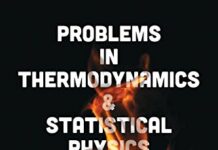
Ebook Info
- Published: 2014
- Number of pages: 480 pages
- Format: PDF
- File Size: 5.43 MB
- Authors: Peter T. Landsberg
Description
Innovative and wide-ranging, this treatment combines precise mathematic style with strong physical intuition. Written by a well-known physicist for advanced undergraduates and graduate students, the book’s broad spectrum of applications includes negative temperatures and heat capacities, general and special relativistic effects, black hole thermodynamics, gravitational collapse, energy conversion problems, and efficiencies including simple heat pump theory.The basic ideas and mathematical formulation of thermodynamics are presented in a modern, clear way with the Carathéodory method, which is employed fully, but in simple terms and without advanced mathematics. Statistical mechanics are based on ideas from information theory, and the simpler ideal systems are covered in close connection with the thermodynamic treatment. Mathematical steps are displayed in detail, and abundant problems include worked solutions.
User’s Reviews
Reviews from Amazon users which were colected at the time this book was published on the website:
⭐Words from the author: “For those who are fascinated by the interaction between Physics and Mathematics, several unusual points of interest are raised.” These points of interest encompass (among others):(1) Thermodynamics relationships between Arithmetic and Geometric Means,(2) Entropy Increase and Equivalence Classes,(3) Gibbs Phase Rule and Euler’s Formula.In reading the preface one ascertains that this will be an unusual and somewhat challenging textbook. If the preface is insufficient to whet the reader’s appetite, note appendix D (45 Pages) exhibiting the full solutions to many problems.But, before utilizing the entire scope of this textbook, I do suggest glancing at chapter four: mathematical review.If chapter four (pages 26-33) proceeds with but little difficulty, then the textbook should be entirely approachable.(Of course, calculus, as such, should be firmly in hand before opening to the first page of the first chapter !).Landsberg has written a remarkable textbook. However, much herein will be accomplished in a style sufficiently innovative as to be at odds with many of the more familiar, or popular, offerings (that is, the standard undergraduate textbooks). That being said, I found the text to be far superior (especially in its first 120 pages–thermodynamics) to many of those more popular textbooks. We read :(1) ” The numbering of the Laws of Thermodynamics is result of historical accident.” (page 23).(2) ” The Second Law… the first indication that the direction in which processes can go will play a part…” (page 36).(3) ” The word ‘Potential’ in the term ‘chemical potential’ reflects the tendency for systems to adopt states of the lowest admissible chemical potential, there being an analogy with potential energy.”(page 93).(4) “…these analogies lead one to the so-called Weiss Theory of Ferromagnetism.” (page 105).(5) “…this shows that whereas equilibrium entails detailed balance, the converse does not hold.” (page 120).The above lines, a random sampling from the first eight chapters, offers a concentration in Thermodynamics. We learn of extensive and intensive Variables (page 20 ) and, thereafter, careful explication of such. We learn of Caratheodory’s formulation of the second law. (page 35). The discussion of chemical potential, Section 7.2 (pages 80-82) provides delightful qualitative excursion. The brief introduction to ferromagnetism and critical exponents (pages 104-109) is another highlight. An enormous amount of thoughtful (mathematical and physical) material spans these initial 120 pages of thermodynamics. Second part: statistical mechanics (comprising the following 230 pages):We read:(1) ” Entropy corresponds to a kind of statistical spread…” (page 125: Note, the fine introduction of convex functions on page 130).(2) ” The word ‘partition function’ expresses vaguely what is clear from the equations, that these quantities can be partitioned into sums of a particular type.” (page 137). Also, Section# 9.5.1 will give a rapid-fire, two-page review of quantum mechanics. Fluctuations, first encountered page 151 ( problem# 9.8), serves as a precursor to its second encounter, the entire chapter sixteen on fluctuations ! Fermions and bosons, demarcated (pages 155-157). Occupation numbers for localized spins lucidly expounded Section #10.3 (pages 60-64). Phase space structure for paramagnet is as lucid a discussion ( three pages) as one might hope for at such an elementary vantage-point. If your propensity is heat pumps, engines and the like, fear not, they arrive at the conclusion of chapter ten. Chapter eleven summarized thus: “…replace summations by integrations.” (page 181 or, page 189). A Table (page 201) summarizes the contents of chapter twelve : density of state functions.Chapter thirteen: Blackbody Radiation, a tour-de-force of exposition. Study this chapter assiduously.Chapter fifteen: Fermi Systems, which concludes with a discussion of black holes (six pages) and lasers (two pages).You will be introduced to utilization of the gamma function and the Riemann-Zeta function (pages 274-277).Next, chapter sixteen: Fluctuations. Another tour-de-force. A highlight: discrete energy levels without quantization !Also, Bose-Einstein and Einstein’s theory of Brownian movement espoused. A terse and enriching exposition.The text concludes with foundational issues and a glance into solar cells, relativistic considerations and symmetry.Finally, we read:(1) ” Approximations are always needed to give statistical mechanical descriptions of real systems.” (page 338).(2) “The word ‘order’ has, of course, to be used with care.” (page 358).Appendices are informative: information theory, Lagrange multipliers, solid angles. Suggestions for further reading and bibliographic notes concludes the textbook. Much more awaits the prospective reader. Student problems are exceptional. Solutions to most are provided. The typography is a bit distracting. Happily, one overlooks that minor quibble. Otherwise, a fine resource. Instructors please take note: innovations abound ! A bit more mathematical (that is, axiomatic) than others at this introductory vantage (undergraduate). A possible trajectory for serious study:First, Adkins (Equilibrium Thermodynamics). Second, study Landsberg. Third, study Elliot H. Lieb’s papers.If wanting to make sense of it all, that trilogy (Adkins, Landsberg, Lieb) will supply insight at ever-increasing levels of abstraction. Topping it off: Giles’ Mathematical Foundations Of Thermodynamics (1964, Pergamon).
⭐OK, but dated. The book is mostly statistical mechanics. I wish there was a more detailed treatment of classical thermo. The book is typed manuscript and is not as easy to read as one that is type-set. It is an advanced text and may not be for beginners.
⭐Book is typed with equations often inline. This makes it unnecessarily hard to read. Author states things with a mathematical formalisn that adds nothing to the material and makes it a little more complicated to read. Never-the-less book contains usedul material.
⭐… emphasis on the physics of radiation. Explaining the foundations of thermodynamics and statistical physics Landsberg has a nice part dealing with radiation as a photon gas in a grande-canonical ensemble. A must for any climate scientist and metereologist. The copy I got was second-hand in the old type-writer layout, making the formula a bit clumsy to read.
⭐Peter Landsberg was really a prominent specialist in the field – when reading the book it is becoming clear with every next page !
Keywords
Free Download Thermodynamics and Statistical Mechanics (Dover Books on Physics) in PDF format
Thermodynamics and Statistical Mechanics (Dover Books on Physics) PDF Free Download
Download Thermodynamics and Statistical Mechanics (Dover Books on Physics) 2014 PDF Free
Thermodynamics and Statistical Mechanics (Dover Books on Physics) 2014 PDF Free Download
Download Thermodynamics and Statistical Mechanics (Dover Books on Physics) PDF
Free Download Ebook Thermodynamics and Statistical Mechanics (Dover Books on Physics)

